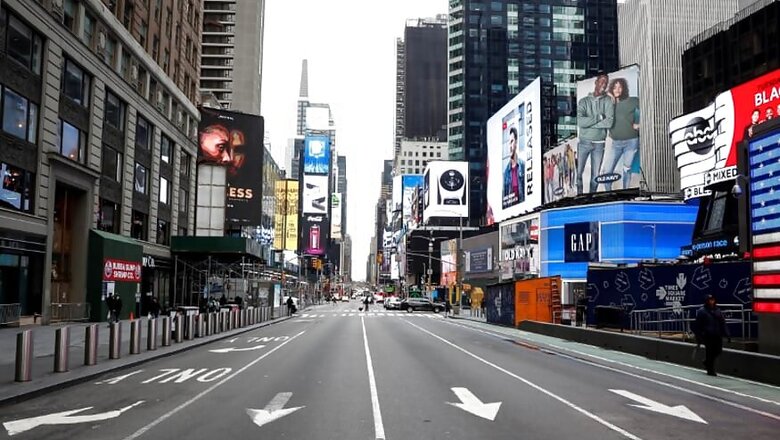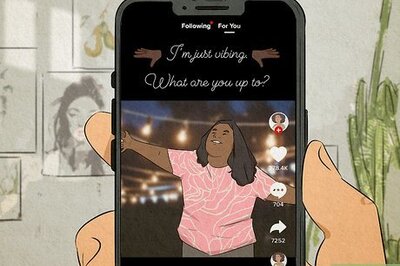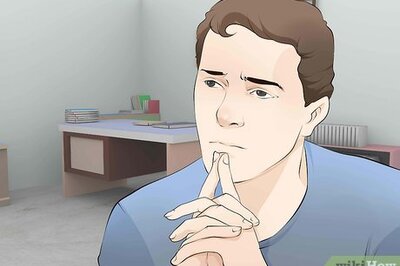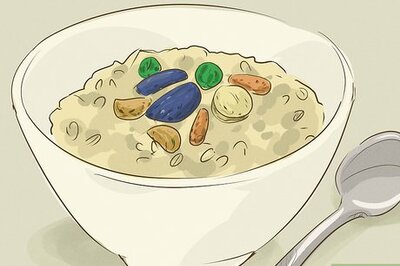
views
New York: Three weeks after its first coronavirus infection was discovered, the New York City region reached an alarming milestone Sunday: It now accounts for roughly 5% of the world’s confirmed cases, making it an epicentre of the global pandemic and increasing pressure on officials to take more drastic measures.
Moving to stem the crisis on multiple fronts, Gov. Andrew Cuomo of New York pleaded with federal officials to nationalize the manufacturing of medical supplies and ordered New York City to crack down on people congregating in public. He suggested some streets could be closed, allowing pedestrians more space.
The governor on Sunday announced measures intended to prepare for a wave of patients, including setting up temporary hospitals in three New York City suburbs and erecting a massive medical bivouac in the Jacob Javits Center on Manhattan’s west side.
Already, hospitals across the New York region are reporting a surge of coronavirus patients and a looming shortage of critical supplies like ventilators and masks. A rapid increase in testing has revealed the extent of the outbreak: Community spread of the highly contagious virus now appears commonplace.
All told, more than 15,000 people in New York state have tested positive, with the vast majority in the New York City region. That is about half of the cases in the United States. Worldwide, the pandemic has sickened more than 314,700 people, according to official counts.
About 1 in 8 patients in New York state has been hospitalized, and 114 people had died by Sunday morning, state officials said, though the toll in New York City rose rapidly during the course of the day. Cuomo said most of the deceased were over age 70, a cohort considered particularly susceptible to the disease’s respiratory attacks.
New York City had an eerie feel all weekend long — bright and sunny, but with commercial streets largely deserted now that restaurants and most stores have been closed to curb the coronavirus. The governor’s newest actions came as New York adopted its toughest measures to stem the spread of the virus: As of 8 p.m. Sunday, all nonessential businesses were ordered closed, an edict that darkened storefronts from Brooklyn to Buffalo. Residents were told to stay inside except for necessities like food, medicine and short bouts of exercise.
Cuomo and Mayor Bill de Blasio have repeatedly emphasized that New York City would not be locked down, saying that all transportation links, including subways and commuter railways, would continue to function — at times on limited schedules. “There’s not going to be chaos, there’s not going to be anarchy,” Cuomo said. But he also warned of months of restrictions.
“The timeline, nobody can tell you, it depends on how we handle it,” Cuomo said. “But 40%, up to 80% of the population will wind up getting this virus. All we’re trying to do is slow the spread, but it will spread.”
While groceries, car repair and takeout food were exempted, the state and city’s normally vibrant commercial and social life was being put “on pause,” as Cuomo put it, resulting in enormous numbers of layoffs and frantic shoppers stockpiling food and other supplies in advance of the 8 p.m. deadline.
In New York City, where hundreds of cases were being reported in every borough, de Blasio was equally blunt about the days ahead. “We are now in New York City the epicenter of this crisis in the United States of America,” de Blasio said. “I am not happy to tell you that. You’re not happy to hear it.”
Earlier in the day, de Blasio warned, “The worst is yet to come. April is going to be a lot worse than March. And I fear May could be worse than April.” Late Sunday, the city released stark new figures that showed 1,800 people hospitalized, including 450 in intensive care units. All told, the city reported 10,764 positive cases of coronavirus, with more than 3,000 cases each in Brooklyn and Queens. There were now 99 fatalities.
The mayor, who has been harshly critical of the federal response, said he spoke to Trump and Vice President Mike Pence late Sunday, and said the two men seemed to sense the urgency of the situation. “I want to see this help arrive rapidly,” de Blasio said, adding that the city’s public hospitals were “10 days away from running out of really basic supplies.
Indeed, hospitals in the New York City region were confronting a wave of patients even as they prepared for more dire circumstances.
The governor told the hospitals to double capacity in expectation of a rising tide of sick people. The influx was already apparent at places like NewYork-Presbyterian, where officials said they’d seen more than 500 coronavirus patients by Sunday morning. The hospital instituted a variety of rules to control spread of the virus, including banning partners from pregnant women’s delivery rooms.
The state was also repurposing existing health care facilities including nursing homes to act as temporary hospitals, even as the Federal Emergency Management Agency and the U.S. Army Corps of Engineers made plans to turn the Javits Center into a temporary medical center.
All told, upward of 2,000 beds will be prepped inside the convention center, some manned by federal emergency personnel. The governor was still asking for more help with staffing and supplies, saying that the states were vying for the same emergency products, causing prices for basic items like protective masks to soar.
“This state cannot manage it, states all across the country can’t manage it,” said Cuomo, a third-term Democrat, adding, “I’m competing with California and Illinois and Florida, and that’s not the way it should be.”
he also asked President Donald Trump to utilize the Defense Production Act, a Cold-War-era law that allows factories to be repurposed, mixing praise for the president with more direct appeals for assistance from federal authorities. Cuomo went out of his way to criticize the behavior of some New York City residents, who he said were endangering themselves and others by continuing to crowd parks, playgrounds and public spaces.
“It’s insensitive, it’s arrogant, it’s self-destructive, it’s disrespectful to other people and it has to stop,” Cuomo said. “And it has to stop now.” Thousands of tests continued to be conducted, even as some city leaders suggested that the disease had become so endemic that resources might be better used on treating patients than identifying them.
Councilman Mark D. Levine, D-Manhattan, who chairs the City Council’s health committee, said on Twitter on Sunday that the number of positive cases was unimportant. “Only one thing matters now: treatment of the gravely ill,” Levine wrote.
Jesse McKinley c.2020 The New York Times Company




















Comments
0 comment